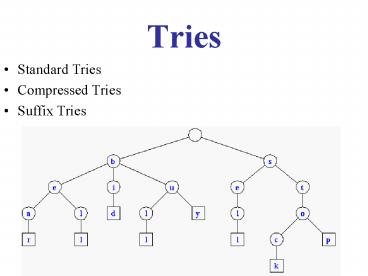Tries PowerPoint PPT Presentation
Title: Tries
1
Tries
- Standard Tries
- Compressed Tries
- Suffix Tries
2
Text Processing
- We have seen that preprocessing the pattern
speeds up pattern matching queries - After preprocessing the pattern in time
proportional to the pattern length, the
Boyer-Moore algorithm searches an arbitrary
English text in (average) time proportional to
the text length - If the text is large, immutable and searched for
often (e.g., works by Shakespeare), we may want
to preprocess the text instead of the pattern in
order to perform pattern matching queries in time
proportional to the pattern length. - Tradeoffs in text searching
3
Standard Tries
- The standard trie for a set of strings S is an
ordered tree such that - each node but the root is labeled with a
character - the children of a node are alphabetically ordered
- the paths from the external nodes to the root
yield the strings of S - Example standard trie for
- the set of strings
- S bear, bell, bid, bull,
- buy, sell, stock, stop
- A standard trie uses O(n) space. Operations
(find, insert, remove) take time O(dm) each,
where - -n total size of the strings in S,
- -m size of the string parameter of the
operation - -d alphabet size,
4
Applications of Tries
- A standard trie supports the following operations
on a preprocessed text in time O(m), where m
X - -word matching find the first occurence of word
X in the text - -prefix matching find the first occurrence of
the longest prefix of word X in the text - Each operation is performed by tracing a path in
the trie starting at the root
5
Compressed Tries
- Trie with nodes of degree at least 2
- Obtained from standard trie by compressing chains
of redundant nodes
Standard Trie
Compressed Trie
6
Compact Storage of Compressed Tries
- A compressed trie can be stored in space O(s),
where s S, by using O(1) space index ranges
at the nodes
7
Insertion and Deletioninto/from a Compressed Trie
8
Suffix Tries
- A suffix trie is a compressed trie for all the
suffixes of a text - Example
Compact representation
9
Properties of Suffix Tries
- The suffix trie for a text X of size n from an
alphabet of size d - -stores all the n(n-1)/2 suffixes of X in O(n)
space - -supports arbitrary pattern matching and prefix
matching queries in O(dm) time, where m is the
length of the pattern - -can be constructed in O(dn) time
10
Tries and Web Search Engines
- The index of a search engine (collection of all
searchable words) is stored into a compressed
trie - Each leaf of the trie is associated with a word
and has a list of pages (URLs) containing that
word, called occurrence list - The trie is kept in internal memory
- The occurrence lists are kept in external memory
and are ranked by relevance - Boolean queries for sets of words (e.g., Java and
coffee) correspond to set operations (e.g.,
intersection) on the occurrence lists - Additional information retrieval techniques are
used, such as - stopword elimination (e.g., ignore the a
is) - stemming (e.g., identify add adding added)
- link analysis (recognize authoritative pages)
11
Tries and Internet Routers
- Computers on the internet (hosts) are identified
by a unique 32-bit IP (internet protocol) addres,
usually written in dotted-quad-decimal notation - E.g., www.cs.brown.edu is 128.148.32.110
- Use nslookup on Unix to find out IP addresses
- An organization uses a subset of IP addresses
with the same prefix, e.g., Brown uses
128.148.., Yale uses 130.132.. - Data is sent to a host by fragmenting it into
packets. Each packet carries the IP address of
its destination. - The internet whose nodes are routers, and whose
edges are communication links. - A router forwards packets to its neighbors using
IP prefix matching rules. E.g., a packet with IP
prefix 128.148. should be forwarded to the Brown
gateway router. - Routers use tries on the alphabet 0,1 to do
prefix matching.

